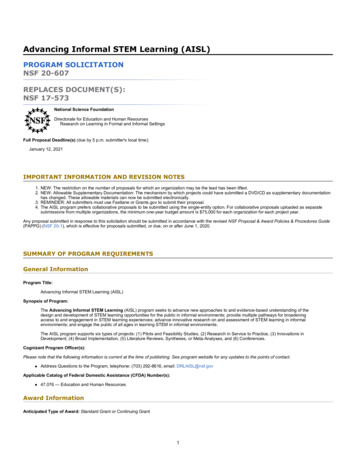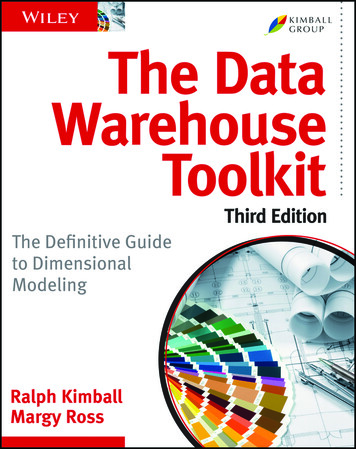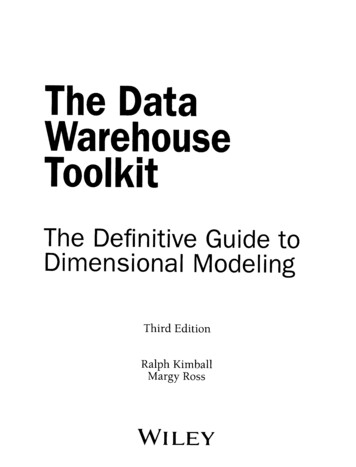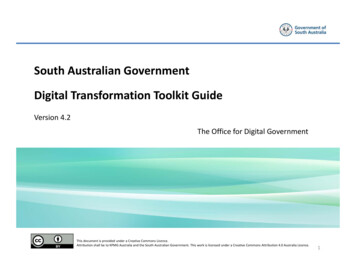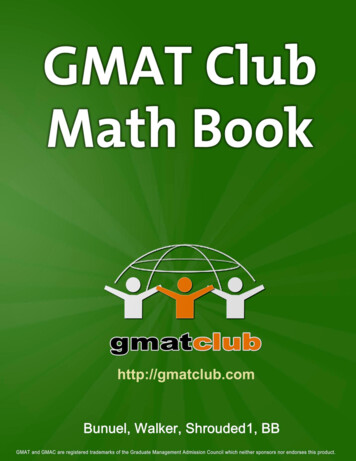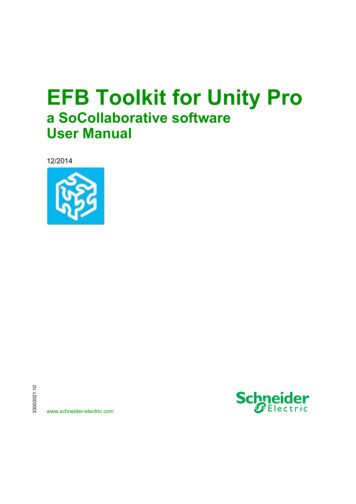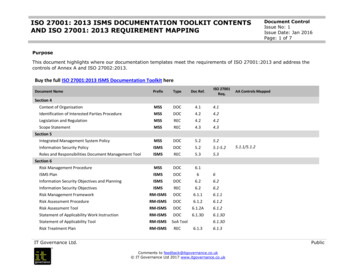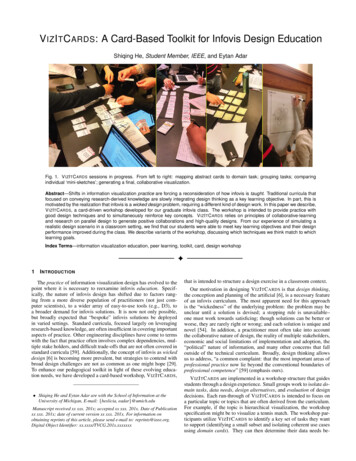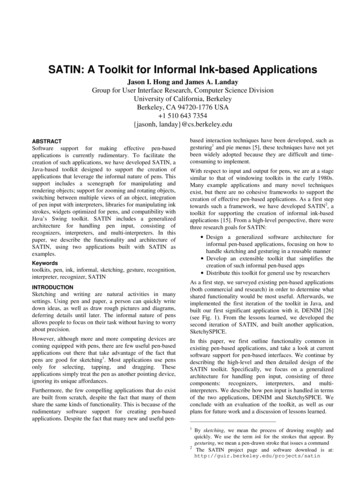
Transcription
SATIN: A Toolkit for Informal Ink-based ApplicationsJason I. Hong and James A. LandayGroup for User Interface Research, Computer Science DivisionUniversity of California, BerkeleyBerkeley, CA 94720-1776 USA 1 510 643 7354{jasonh, landay}@cs.berkeley.eduABSTRACTSoftware support for making effective pen-basedapplications is currently rudimentary. To facilitate thecreation of such applications, we have developed SATIN, aJava-based toolkit designed to support the creation ofapplications that leverage the informal nature of pens. Thissupport includes a scenegraph for manipulating andrendering objects; support for zooming and rotating objects,switching between multiple views of an object, integrationof pen input with interpreters, libraries for manipulating inkstrokes, widgets optimized for pens, and compatibility withJava’s Swing toolkit. SATIN includes a generalizedarchitecture for handling pen input, consisting ofrecognizers, interpreters, and multi-interpreters. In thispaper, we describe the functionality and architecture ofSATIN, using two applications built with SATIN asexamples.based interaction techniques have been developed, such asgesturing1 and pie menus [5], these techniques have not yetbeen widely adopted because they are difficult and timeconsuming to implement.With respect to input and output for pens, we are at a stagesimilar to that of windowing toolkits in the early 1980s.Many example applications and many novel techniquesexist, but there are no cohesive frameworks to support thecreation of effective pen-based applications. As a first steptowards such a framework, we have developed SATIN2, atoolkit for supporting the creation of informal ink-basedapplications [15]. From a high-level perspective, there werethree research goals for SATIN: Design a generalized software architecture forinformal pen-based applications, focusing on how tohandle sketching and gesturing in a reusable manner Develop an extensible toolkit that simplifies thecreation of such informal pen-based apps Distribute this toolkit for general use by researchersKeywordstoolkits, pen, ink, informal, sketching, gesture, recognition,interpreter, recognizer, SATININTRODUCTIONSketching and writing are natural activities in manysettings. Using pen and paper, a person can quickly writedown ideas, as well as draw rough pictures and diagrams,deferring details until later. The informal nature of pensallows people to focus on their task without having to worryabout precision.However, although more and more computing devices arecoming equipped with pens, there are few useful pen-basedapplications out there that take advantage of the fact thatpens are good for sketching1. Most applications use pensonly for selecting, tapping, and dragging. Theseapplications simply treat the pen as another pointing device,ignoring its unique affordances.Furthermore, the few compelling applications that do existare built from scratch, despite the fact that many of themshare the same kinds of functionality. This is because of therudimentary software support for creating pen-basedapplications. Despite the fact that many new and useful pen-As a first step, we surveyed existing pen-based applications(both commercial and research) in order to determine whatshared functionality would be most useful. Afterwards, weimplemented the first iteration of the toolkit in Java, andbuilt our first significant application with it, DENIM [26](see Fig. 1). From the lessons learned, we developed thesecond iteration of SATIN, and built another application,SketchySPICE.In this paper, we first outline functionality common inexisting pen-based applications, and take a look at currentsoftware support for pen-based interfaces. We continue bydescribing the high-level and then detailed design of theSATIN toolkit. Specifically, we focus on a generalizedarchitecture for handling pen input, consisting of threecomponents: recognizers, interpreters, and multiinterpreters. We describe how pen input is handled in termsof the two applications, DENIM and SketchySPICE. Weconclude with an evaluation of the toolkit, as well as ourplans for future work and a discussion of lessons learned.1LEAVE BLANK THE LAST 2.5cmOF THE LEFT COLUMNON THE FIRST PAGEFOR US TO PUT INTHE COPYRIGHT NOTICE!2By sketching, we mean the process of drawing roughly andquickly. We use the term ink for the strokes that appear. Bygesturing, we mean a pen-drawn stroke that issues a commandThe SATIN project page and software download is at:http://guir.berkeley.edu/projects/satin
Commercial Software Support for PensPalmOS [8] offers some very simple pen input processing.The default behavior is to process strokes and taps in thesilk screen area as key events, with all other strokes passedon to the application for processing. PalmOS also providessome APIs for getting individual stroke points, enablingand disabling the Graffiti shorthand recognizer, and forgetting the last known location of the pen.Figure 1 – A screenshot of DENIM, a sketch-based website design tool created on top of SATINPEN APPLICATION SPACERecently, there have been many applications developed thatuse sketching and gesturing. We performed a survey ofthese applications, looking specifically for examples ofinformal ink-based interaction, ones that step away fromrigid structure and precise computation, instead supportingambiguity, creativity, and communication [15]. Many penbased research systems have headed in the direction ofinformal interfaces in recent years, either by not processingthe ink [11, 41, 43] or by processing the ink internally whiledisplaying the unprocessed ink [14, 24, 32, 40].The applications we examined include design tools [9, 12,14, 20-22, 24, 43, 47]; whiteboard applications [1, 32, 33,37]; annotation tools [41, 44-46]; note-taking applications[10, 11, 42]; and applications demonstrating newinteraction techniques [19, 28, 40]. These applicationsshare much functionality with each other, including: Pen input as inkPen input as gesturesPen input for selecting and movingInterpreters that act on ink inputManipulation of other kinds of objects besides inkGrouping of objectsLayering of objectsTime indexing of ink inputTransformation of ink to other cleaned-up objectsImmediate and deferred processing of inkLater, in the process of developing DENIM, our firstapplication, we discovered we needed techniques formanaging information, and turned to using zooming andsemantic zooming, as demonstrated in Pad [3] and Jazz[4]. We decided that this functionality was useful enough todevelopers that it should be included in the toolkit.EXISTING PEN FRAMEWORKSIn this section, we outline existing frameworks fordeveloping pen-based applications, and describe whereSATIN builds on their ideas.Microsoft Windows for Pen Computing [29] providesminimal support for pens. Text entry areas were replacedeither by handwriting edit controls (hedit) or by boxededit controls (bedit), in which individual characters canbe written. Simple gesture recognition was also supported.These extensions give the developer very little support forbuilding informal ink-based applications.In Windows CE [30], pen input is treated as a subset ofmouse input. Applications can receive messages when thepen is moved, goes down, comes up, and is double-tapped.Windows CE also provides simple handwriting recognition.NewtonOS [2] uses sheets of paper as its input metaphor.Users can write on these sheets without having to explicitlysave. Furthermore, users can specify several ink modes inwhich strokes are processed as text, as shapes, or leftunprocessed as raw ink. Recognition errors can becorrected by choosing from an n-best list. Gestures are alsointegrated into the system. Drawing a zig-zag shape over aword or shape, known as scrubbing, deletes that object.Holding down the pen for a second activates select mode.After select is enabled, the user can drag the pen and eitherhighlight or circle the objects to select. Lastly, NewtonOSprovides an extensive widget set for pens, designed tominimize the amount of end-user writing necessary.Perhaps the most sophisticated commercial support for penswas in GO Corporation’s PenPoint [6]. PenPoint is anoperating system built from the ground up to support pens.Besides providing many of the services described above,such as gestures and pen widgets, PenPoint also has suchfeatures as live embedding of documents within documents,and extensive integration of gesture recognition andhandwriting recognition.There are two main differences between SATIN and thesystems described above. First, all of the systems listedabove are designed to build formal user interfaces, and arethus focused on handwriting recognition and form entrytasks. In contrast, SATIN is targeted towards thedevelopment of informal ink-based applications. Thesecond difference is extensibility. Aside from handwritingrecognition, the systems listed above provide minimalsupport for manipulating and processing ink. In contrast,one of our primary goals with SATIN was to givedevelopers flexibility in how ink is processed and to make itsimple to do so. For example, new gestures cannot be addedin the systems described above.
Research Software Support for PensSimple ink and gesture support is provided in Artkit [16].Artkit uses the notion of sensitive regions, invisiblerectangles that can be placed on top of screen objects. Thesensitive region intercepts stroke input, and processes theinput in a recognition object, which possibly forwards ahigher-level event to the screen object underneath.Mankoff et al., extended the subArctic toolkit [17] tosupport inking, gesturing, and recognition, specifically forexploring techniques in resolving ambiguity [28].Garnet [23, 34] and Amulet [36] also have support forgestures. A gesture interactor was added to these toolkits tosupport recognizing pen gestures using Rubine’s algorithm[39]. The recognizer simply calls the registered callbackprocedure with the result as a parameter. No other pen andink-based support is provided.Flatland [18, 37] is a lightweight electronic whiteboardsystem that has much in common with SATIN. Flatlanduses the notion of segments to divide up screen space, anduses strokes both as input and as output. Furthermore,behaviors can be dynamically plugged into segments,changing how stroke input is processed and displayed. Thisarchitecture is very similar to SATIN.SATIN is built in Java, using JDK1.33. SATIN uses Java2Dfor rendering, and makes extensive use of the Java coreclasses as well as the Swing windowing toolkit [31].Fig. 2 shows how a pen-based application would be builtusing SATIN, Swing, and Java. Roughly speaking, SATINcan be partitioned into twelve interrelated concepts (SeeTable 1). Each of these concepts is briefly summarized inthe next section. Some of these concepts are very looselycoupled to one another, and can be used independently ofthe rest of the toolkit. In other words, a developer can usesome portions of the SATIN toolkit without a completebuy-in of the entire system.Figure 2 – This diagram shows the relationship betweenJava, Swing, SATIN, and pen-based applications.One clear difference between Flatland and SATIN isFlatland combines mechanism and policy in several cases,mixing how something is done with when it is done. Forexample, in Flatland, all strokes belong to a segment, andnew segments are automatically created if a stroke is notdrawn in an existing segment, whether or not an applicationdesigner wants a new segment. Our goal with SATIN wasto focus on fine-grained mechanisms that can be used for arange of ink-based applications. Another difference is thatFlatland only allows one application behavior to be activein a segment at any time. We introduce the notion of multiinterpreters to manage multiple interpreters.Kramer’s work in translucent patches and dynamicinterpretations [21, 22] significantly influenced the designand implementation of SATIN. We use Kramer’s notions ofpatches and dynamic interpretation, but again, our focus isat the toolkit level.The chief characteristics that differentiate SATIN from allof the work above are flexibility and fine granularity. Weare focused on developing an extensible toolkit. Weprovide a set of mechanisms for manipulating, handling,and interpreting strokes, as well as a library of simplemanipulations on strokes, with which developers can builda variety of informal pen-based applications.HIGH LEVEL DESIGN OF SATINSATIN is intended to support the development of 2D penbased applications. We chose to support 2D instead of 3Dsince most of the applications surveyed utilize twodimensions only. The current implementation of SATINdoes not support multiple users, as that introduces anotherlevel of complexity beyond the scope of this icationsCommandsWidgetsCan use outside SATIN?NoNoNoNoSome portionsNoSome portionsNoNoYesYesYesFor pens only?NoNoNoNoYesYesYesYesNoNoNoYesTable 1 – The twelve major components in SATIN. Someportions of SATIN have been designed to be independentof the rest of the system and can be used outside of SATIN.Design OverviewWe call objects that can be displayed and manipulatedgraphical objects. Like most 3D modeling systems (such asJava3D and OpenGL) we use the notion of a scenegraph, atree-like data structure that holds graphical objects andgroups of graphical objects. The simplest graphical objectthat the user can create is a stroke, which is automaticallycreated in SATIN by the path drawn by a pen or mouse.Another primitive graphical object is a patch, an arbitrarilyshaped region of space that can contain other graphical3We began SATIN in JDK1.2, and transitioned to each earlyaccess version of the JDK as they were released.
objects. Patches interpret strokes either as gestures or asink. Our notion of patches is derived from the work byKramer [21, 22]. SATIN also provides a sheet, which is aJava Swing component as well as a graphical object. ASheet serves as the root of a scenegraph, and is essentially adrawing canvas that can contain SATIN objects.Graphical objects have x-, y-, and layer-coordinates. The xaxis and y-axis coordinates are Cartesian coordinates. Thelayer-coordinate is used to denote the relative position ofone graphical object to another along the z-axis. That is,SATIN simply keeps track of which objects are on top ofothers, but does not store exact z-axis coordinates.Graphical objects also have styles. Styles take many of thegraphics concepts in Java, such as line style, color, andfont, and translucency, abstracting them out into a singleobject. Styles are automatically applied by the renderingsubsystem when rendering.When rendering, SATIN uses the same damage-redrawcycle that is standard in windowing systems. The systemnever repaints a region unless it is marked damaged. If anarea is damaged, then only the graphical objects in thedamaged area are traversed. For common operations, suchas translation and rotation, graphical objects automaticallydamage the region they are in. For application-specificoperations, however, the developer may need to explicitlycall the damage method.SATIN also automatically changes the rendering qualitydepending on the current context. For example, when theuser is drawing strokes, the damaged areas are rendered inlow quality in order to speed up performance. However,when the stroke is completed, SATIN reverts to the highestquality rendering level.Graphical objects have one or more view objects, whichdictate how a graphical object is drawn. If a graphicalobject has more than one view, then it must also have aMultiView, an object that specifies the policy of which viewobjects are rendered and when. An example multi-view wehave included is a Semantic Zoom Multi View, which usesthe current zoom scale to choose the view to be displayed,as in Pad [3] and Jazz [4].SATIN provides support for simple transitions on graphicalobjects, such as zooming and rotation. Given a graphicalobject and a transform, the system can automaticallygenerate and render the intermediate steps, providing asmooth animation. The default transition type is Slow-In /Slow-Out [7, 25], a transition that spends the majority oftime in the beginning and in the end of the animation.There are also several classes for manipulating strokes. Thestroke assembler aggregates user input into strokes anddispatches them as events to graphical objects. Eachgraphical object knows how to handle stroke events, andcan choose how the stroke events are handled. This processis described in more detail in the Detailed Design section.There are also utility classes for manipulating strokes, suchas splitting strokes, merging strokes, turning strokes intostraight lines, and for simplifying strokes.We use the term recognizers to mean subsystems used toclassify ambiguous input, such as ink strokes. In SATIN,we have defined recognizers as objects that take some kindof ambiguous input and return a well-defined n-best list ofclassifications and probabilities ordered by probability.This definition allows us to plug in other stroke recognizersinto the system. Examples of stroke recognizers includeRubine’s recognizer [38, 39] and neural net recognizers.Currently, SATIN only contains the gdt [27]implementation of Rubine’s recognizer. Recognizers mayor may not retain state across classifications. However,recognizers do not take any kind of action based on the actof classification. Instead, this is left to interpreters.Interpreters take action based on user-generated strokes.For example, one interpreter could take a stroke andtransform it into a straight line. A different interpreter couldissue a command if the stroke resembled a gesture in thesystem. Interpreters can use recognizers to classify strokes,but are not required to do so.We distinguish between gesture interpreters and inkinterpreters. A gesture interpreter tries to process a strokeas a command (e.g., cut), while an ink interpreter processesa stroke and displays the result as ink (e.g., straightens itout). We also make the distinction between progressivestroke interpreters and single-stroke interpreters. Aprogressive-stroke interpreter tries to perform actions as astroke is being drawn, while a single-stroke interpreter onlytakes action after a stroke is completed. SATIN currentlydoes not support multi-stroke interpreters.A graphical object can have one or more gestureinterpreters, as well as one or more ink interpreters. Likeviews, a MultiInterpreter specifies the policy for whichinterpreters are used when more than one is present. Multiinterpreters are a new concept introduced in SATIN, andare discussed in the Detailed Design section.The clipboard acts the same as in modern GUIs, supportingcut, copy, and paste for graphical objects.Notifications are messages generated and sent internallywithin the system in order to maintain consistency. Thesemessages are often used to maintain constraints betweengraphical objects or to notify objects that a graphical objecthas been deleted.Commands are a common design pattern used forsupporting macros, as well as undo and redo [13, 35].Commands reify operations by encapsulating a transactioninto an object that knows how to do, undo, and redo itself.SATIN’s command subsystem extends the one provided inJava Swing (javax.swing.undo), by adding in thenotion of executing a command (instead of simply undoingan operation). The command subsystem also has a notion oftime, tracking when commands were executed, as well asallowing classes of commands to be enabled and disabled.
Application developers are not required to use thecommand subsystem in order to use SATIN. The Commandsubsystem can also be used outside of SATIN.SATIN also provides some widgets optimized for pens.Currently, the only new widget we provide is a pie menu [5]that can be used as a normal Java Swing widget. The piemenuimplementsjavax.swing.MenuElement,Swing’s menu interface, and in many cases can be used inlieu of normal pop up menus with few changes to the code.Figure 3 – Classes bridging the gap between SATIN and JavaSwing. Swing widgets can be displayed in SATIN, and SATINgraphical objects can be embedded in Swing applications.We also provide a Pen Pluggable Look and Feel(PenPLAF). The PenPLAF uses Java Swing’s pluggablelook and feel [31] to modify the standard file opener andslider widgets to make them easier to use for pens. The fileopener was modified to accept single mouse clicks to openfolders (instead of double clicks). The slider was modifiedto have a larger elevator, as well as the ability to have theslider value changed by tapping anywhere on the slider. Thepie menu and the PenPLAF are not tied to SATIN, and canbe used in Java applications outside of the toolkit.Bridging the Gap between Java Swing and SATINWe also provide some classes to help bridge the gapbetween SATIN and Java Swing (See Fig. 3). Currently,SATIN support for Swing consists of two classes. The first,GObJComponent4, wraps up Swing widgets in a SATINgraphical object. Thus, Swing widgets can be displayed inSATIN, though full interaction (e.g., keyboard input), hasnot yet been completed. The second, GObImage, allowsJava Image objects to be displayed in SATIN. Thisenables SATIN to be able to display any image file formatthat Java understands.Conversely, SATIN can be used in Swing applications. Asstated before, the Sheet is both the root of a scenegraph inSATIN and is a fully compatible Swing widget. AJSatinComponent is a Swing widget that wraps arounda SATIN graphical object, letting SATIN graphical ImageLib provides some utilities for turningSATIN graphical objects into Java Image objects. Thisenables SATIN to be able to write out to any image fileformat that Java understands.DETAILED DESIGN OF SATIN INK HANDLINGIn this section, we describe strokes, recognizers, andinterpreters in more detail, as well as how they interact witheach other at runtime.Figure 4 – Two example policies of splitting strokes. The thickerline is a gesture created by pressing the right button.Figure 5 – At the top, two separate strokes near each other arecombined into a single stroke. In the middle, two separatestrokes that intersect near their endpoints are merged into asingle stroke. At the bottom, two separate strokes that intersectnear both of their endpoints are merged into a closed shape.StrokesIn SATIN, strokes are simply a list of (x, y, t) tuples,where x is the x-coordinate, y is the y-coordinate, and t isthe time the point was generated (since the Unix epoch).SATIN also provides some utilities and interpreters formanipulating strokes, including splitting a stroke into4JComponent is the parent class of all Swing widgets.Figure 6 – Two examples of straightening strokes.
smaller substrokes, merging strokes together, straighteningstrokes into straight lines, and simplifying strokes.Strokes can be split by specifying a rectangle in which allsubstrokes will be removed. Fig. 4 shows a sampleinterpreter that removes substrokes that lie in the boundingbox of the gesture stroke.Fig. 5 shows some examples of merging strokes. To see iftwo strokes can be merged, the algorithm first checks if thetwo strokes are near each other. If they are, then thealgorithm checks if either extremity of one stroke is near anextremity of the other. If a successful match is made, thenthe two extremities are joined together in a new stroke, withshort trailing ends discarded.SATIN straightens strokes by changing strokes to lines thatgo up, down, left, or right (See Fig. 6). To straighten astroke, we first examine each pair of adjacent points andclassify each pair as going up, down, left, or right. For eachsubsequence of points that is going the same direction, wecreate a line that goes through the average value of thatsubsequence. After this is done, all of the lines created arejoined together and returned as a new stroke.Figure 7 – Two examples of stroke simplification. Thealgorithm generates a stroke similar to the original stroke,but has fewer points and can thus be rendered faster.SATIN also provides utilities for simplifying strokes (SeeFig. 7). This technique is automatically used to help speedup animated transitions. The following approach is used tosimplify a stroke: For each point, calculate the absolute angle relativeto the stroke’s top-left corner using atan2()Calculate the angle delta between each adjacent pairof pointsAdd the starting and ending point of the originalstroke to the simplified strokeGo through the deltas and add each local minima tothe simplified strokeOnce a stroke is simplified, it is cached in the system. On asample set of fifty strokes, the number of points reducedranged from 20% to 50%, averaging a 32% reduction.Using a battery of performance regression tests using 100 to1000 strokes, the performance speedup5 for animating thesimplified strokes ranged from 1.02 to 1.34, with anaverage speedup 1.11. Speedup improves somewhatlinearly as the number of strokes is increased, as expected.5Speedup overall Execution time old / Execution time newRecognizersIn SATIN, a recognizer is a subsystem that classifiesambiguous input, which in our case are strokes. SATINdefines a standard interface for two types of recognizers:progressive stroke and single stroke recognizers. Thesedefinitions are not mutually exclusive, so a recognizer couldbe both a progressive and a single stroke recognizer.SATIN also defines a Classification object, whichrecognizers are defined to return when passed a stroke toclassify. The classification is simply an n-best list of beliefs,ordered by probability. This definition for recognizersmeans that new recognizers can be plugged into the systemsimply by implementing the defined interface.InterpretersThe class diagram in Fig. 8 illustrates the relationshipbetween the classes used for interpretation, and shows someof the interpreters built in SATIN.Besides processing strokes, interpreters are also strokeevent filters, meaning they can specify what kinds of strokesthey will accept. The simplest filter accepts or rejectsstrokes depending on which pen button was held whencreating the stroke. Another kind of filter rejects strokesthat are too long. In addition to filtering, individualinterpreters can also be disabled, meaning that they will notprocess any strokes at all.Some of the interpreters, on the right side of Fig. 8, havealready been discussed (see above), or will be discussedwith DENIM and SketchySPICE (next section). The moreinteresting part is the left portion of Fig. 8, which shows themulti-interpreters. Multi-interpreters are collections ofinterpreters combined with a policy that controls whichinterpreters are used and when they are used.The default multi-interpreter is the Default MultiInterpreter, which simply calls all of the interpreters itcontains, stopping when one of the interpreters says that ithas successfully handled the stroke. The Multiplexed MultiInterpreter lets the developer specify one interpreter asactive, which can be changed at runtime. The SemanticZoom Multi Interpreter enables and disables interpretersdepending on the current zoom level.Runtime Handling of StrokesStrokes are dispatched to graphical objects in a top-downmanner: strokes are sent first to the parent before being redispatched to any of the parent’s children. A stroke is redispatched to a child only if the child contains the strokeentirely (within a certain tolerance). By default, graphicalobjects handle strokes in a four-step process, as follows: Process the stroke with the gesture interpretersRe-dispatch the stroke to the appropriate childrenProcess the stroke with the ink interpretersHandle the stroke in the graphical object
Figure 8 – Class diagram for Interpreters and Recognizers. Arrows point up towards parent classes. Rounded rectanglesare interfaces; dashed square rectangles are abstract classes, and solid square rectangles are concrete classes.At any point in this process, an interpreter or a graphicalobject can mark the stroke as being handled, whichimmediately stops the dispatching process. We give someexamples of how strokes are handled in the DENIM andSketchySPICE sections below.We chose this four-step approach as the default in order toseparate handling of gestures from handling of ink.Processing gestures first lets gestures be global on theSheet, or within a patch. This default approach can also beoverridden in user code.APPLICATIONS BUILT WITH SATINIn this section, we describe two applications built using theSATIN toolkit, their high-level architectures, as well ashow strokes are processed and interpreted in each.sticky, meaning that they are always displayed the samesize, to ensure that they can always be read at the same sizethey were created. Panels are located beneath labels, andrepresent the content in a web page. Ink strokes are whatare drawn in a panel. Phrases are collections of nearbystrokes automatically aggregated together. Arrows connectink and phrases from one page to another page.Currently, DENIM only uses single stroke interpreters. Allstrokes are first passed through the Sheet’s gestureinterpreters, and then, if rejected by all of the gestureinterpreters, are passed to the ink interpreters6. The gestureinterpreters used in DENIM are all provided by SATIN,and include (in the order called): First Application – DENIMDENIM [26] is a web site design tool aimed at the earlystages of information, navigation, and interaction design(See Figs. 1 and 9). An informal pen-based system [15], itallows designers to quickly sketch web pages, create linksamong them, and interact with them in a run mode.Zooming is used to integrate the different ways of viewing aweb site, from site map to storyboard to individual page. Although there are many gesture and ink interpreters inDENIM, from a user perspective, DENIM seems to use
rendering objects; support for zooming and rotating objects, switching between multiple views of an object, integration of pen input with interpreters, libraries for manipulating ink strokes, widgets optimized for pens, and compatibilit
